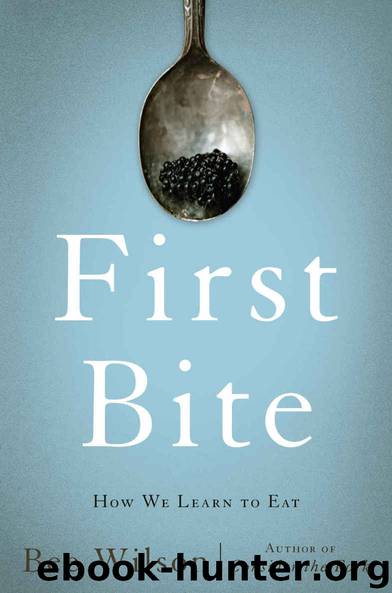First Bite: How We Learn to Eat by Wilson Bee

Author:Wilson, Bee [Wilson, Bee]
Language: eng
Format: epub, azw3, azw
Tags: Food Science, Science
ISBN: 9780465064984
Google: uu1UrgEACAAJ
Barnesnoble:
Publisher: Basic Books
Published: 2015-12-01T06:00:00+00:00
One of the biggest obstacles to any overweight or obese child losing weight is when parents do not see that there is anything wrong. Dr. Laura Stewart runs child obesity clinics in Tayside in Scotland, which has some of the worst child health outcomes in Europe. “A lot of parents do not perceive their child has weight problems,” Stewart told a conference of health professionals I attended in October 2013. The problem, in Stewart’s view, is that the media only shows photographs of “the most exceedingly obese children” when discussing the issue, which leaves people whose children are only mildly obese thinking that they are perfectly fine. If most of the people you see around you are overweight, it starts to seem normal.
Stewart told us of an experiment she did in Tayside in 2010 that was aimed at finding out what it would take to make parents see that their child has a weight problem. Parents were shown photographs of children and asked to group them into “normal” and “overweight.” It was as if they couldn’t grasp what was in front of them. These parents could only recognize a problem with weight when the child in the picture was actually “significantly obese.” All of the photos of children who were overweight, rather than obese, were seen as “normal.” There is a lot of collective denial when it comes to children and weight. It is even there among some of the doctors and nurses whose job it is to deal with it. Around half of those employed by the National Health Service (NHS) in Great Britain are now overweight or obese, making it seem normal for them, too. After Stewart had finished talking, a health worker in the audience put up her hand and criticized Stewart for using the body mass index system in evaluating children. “You could have a fat but fit child! On the BMI system, a body builder could be classified as obese!” Stewart collects herself and smiles. “I’ve never once had a fit muscular child referred to my clinic. You do have to use your eyes.”
The problem of “weight misperception” has consistently been shown to be worse with boys than with girls. Numerous studies have shown that parents are less likely to think a brother is overweight than a sister, perhaps because a boy’s figure is seen as less of a social issue than a girl’s. Parents often become very defensive when a nurse or dietician points out that, based on the weight and height charts, their child is obese. They protest that their child is “big-boned,” that they only eat healthy food, that there’s something wrong with the chart. This defensiveness is seen in parents of girls as well as boys, but with boys, the parents seem almost proud of their son’s large physique. An obese boy may be described as “solid” or “chunky,” which sounds healthier than “fat.” A low-income mother whose preschool son was borderline obese told researchers, “I can look at him, and he might weigh a lot, of course, but that could be just all muscle.
Download
First Bite: How We Learn to Eat by Wilson Bee.azw3
First Bite: How We Learn to Eat by Wilson Bee.azw
This site does not store any files on its server. We only index and link to content provided by other sites. Please contact the content providers to delete copyright contents if any and email us, we'll remove relevant links or contents immediately.
How to Be a Bawse: A Guide to Conquering Life by Lilly Singh(7167)
Deep Work by Cal Newport(6592)
The Longevity Diet by Valter Longo(4864)
The Fat Loss Plan by Joe Wicks(4632)
The Four-Pack Revolution by Chael Sonnen & Ryan Parsons(3800)
The Ultimate Bodybuilding Cookbook by Kendall Lou Schmidt(3715)
The French Women Don't Get Fat Cookbook by Mireille Guiliano(3428)
Super Food Family Classics by Jamie Oliver(3252)
Not a Diet Book by James Smith(3161)
Turn Up Your Fat Burn! by Alyssa Shaffer(3065)
Factfulness_Ten Reasons We're Wrong About the World_and Why Things Are Better Than You Think by Hans Rosling(3053)
Self-Esteem by Matthew McKay & Patrick Fanning(2962)
Tom Kerridge's Dopamine Diet: My low-carb, stay-happy way to lose weight by Kerridge Tom(2958)
Body Love by Kelly LeVeque(2909)
The Unbecoming of Mara Dyer by Michelle Hodkin(2870)
The Fat Chance Cookbook by Robert H. Lustig(2645)
Tone Your Tummy Type by Denise Austin(2640)
LL Cool J's Platinum 360 Diet and Lifestyle by LL Cool J(2588)
Men's Health Best by Men's Health Magazine(2398)
